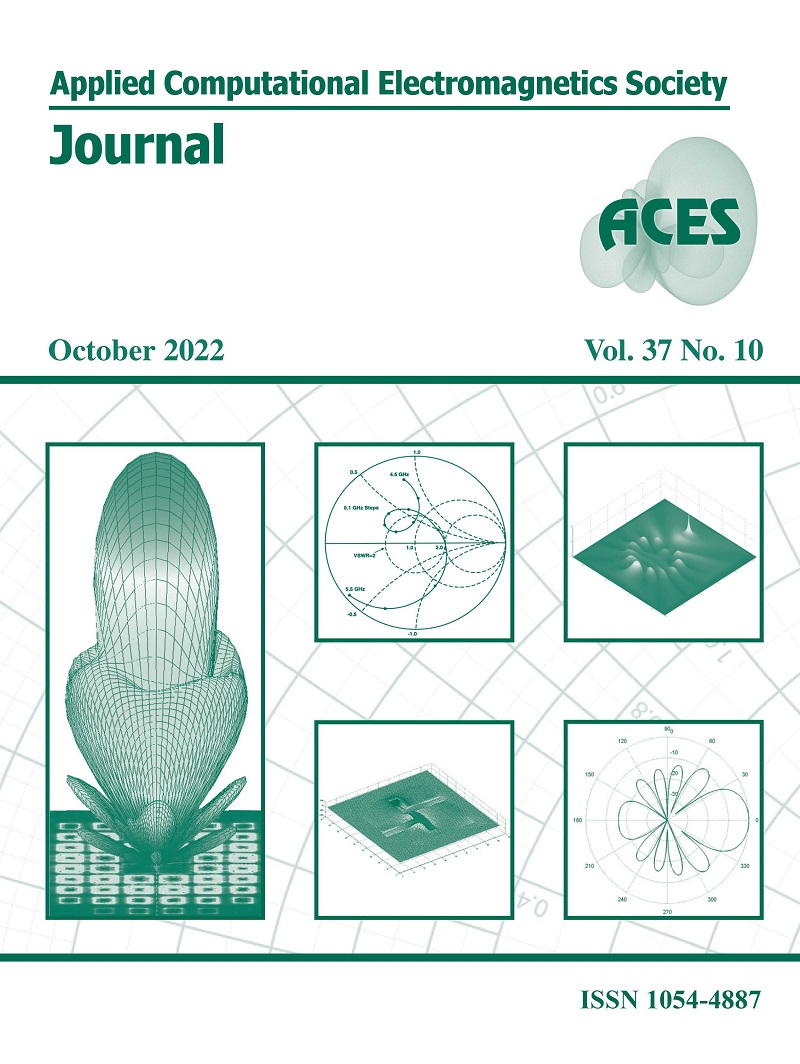Estimation of Soil Electric Properties and Water Content Through PolSAR Target Decomposition
DOI:
https://doi.org/10.13052/2022.ACES.J.371006Keywords:
PolSAR, Target Decomposition, soil parametersAbstract
A new method is proposed to recover the electric properties and water content of ground soil by applying the Target Decomposition (TD) theory for Polarimetric Synthetic Aperture Radar (PolSAR) images. The proposed method depends on the ϵ-σ characteristic curves of the soil which are unique for each soil type at a specific frequency. This method is examined for the clayey type soil which is found in most naturally vegetated land areas. Also, a novel method is developed for the realistic simulation of PolSAR images of natural lands, including forest regions, grasslands, and bare lands being prepared for gardens or crop cultivation. This method is based on the reverse of the PolSAR TD theory. The numerical results presented in this paper are concerned with the characterization of the most common type of clayey soil. Also, some of the numerical results presented in the present paper aim to achieve realistic PolSAR datasets using the inverse TD theory. Finally, some numerical results are presented for quantitative assessment of the method proposed to recover the properties and water content of the clayey soil using the datasets which are obtained through realistic simulations of forested areas, gardens, grasslands, and bare lands being prepared for cultivated plants. It is found, through the numerical investigations and quantitative assessment, that the dielectric constant, electric conductivity and water content of the investigated clayey types of soil are accurately estimated.
Downloads
References
F. Visconti and J. M. de Paz, “Electrical conductivity measurements in agriculture: the assessment of soil salinity,” Chapter 5, New Trends and Developments in Metrology, Intech Open, 2016.
F. Lombardi, M. Lualdi, F. Picetti, P. Bestagini, G. Janszen, and L. A. D. Landro, “Ballistic ground penetrating radar equipment for blast-exposed security applications,” MDPI Remote Sensing, vol. 12, 2020.
A. Al-Yaari, J. P. Wigneron, A. Ducharne, Y. H. Kerr, W. Wagner, G. D. Lannoy, R. Reichle, A. Al Bitar, W. Dorigo, P. Richaume, and A. Mialon, “Global-scale comparison of passive (SMOS) and active (ASCAT) satellite based microwave soil moisture retrievals with soil moisture simulations (MERRA-Land),” Remote Sensing of Environment, pp. 614-626, 2014.
W. Zhao and Z. L. Li, “Sensitivity study of soil moisture on the temporal evolution of surface temperature over bare surfaces,” International Journal of Remote Sensing, vol. 34, pp. 3314-3331, 2013.
K. Das and P. K. Paul, “Present status of soil moisture estimation by microwave remote sensing,” Journal of Cogent Geoscience, vol. 1, 2015.
R. T. Gharechelou, J. T. S. Sumantyo, and B. A. Johnson, “Soil moisture retrieval using polarimetric SAR data and experimental observations in an arid environment,” ISPRS International Journal of Geo-Information, vol. 10, no. 10, pp. 711, 2021.
J. Á. Mozos, J. Casalí, M. G. Audícana, and N. E. C. Verhoest, “Correlation between ground measured soil moisture and RADARSAT-1 derived nackscattering coefficient over an agricultural catchment of Navarre (north of Spain),” Journal of Biosystems Engineering, vol. 92, no. 1, pp. 119-133, Sep. 2005.
G. Bertoldi, S. D. Chiesa, C. Notarnicola, L. Pasolli, G. Niedrist, and U. Tappeiner, “Estimation of soil moisture patterns in mountain grasslands by means of SAR RADARSAT2 images and hydrological modeling,” Journal of Hydrology, vol. 516, pp. 245-257, 2014.
S. A. M. Soliman, K. F. A. Hussein, and A. A. Ammar, “Electromagnetic simulation for estimation of forest vertical structure using PolSAR data,” Progress in Electromagnetics Research B (PIER B), vol. 90, pp. 129-150, 2021.
D. Poreh, A. Iodice, A. Natale, and D. Riccio, “Software tool for soil surface parameters retrieval from fully polarimetric remotely sensed SAR data,” Sensors, vol. 20, no. 18, pp. 1-20, 2020.
V. Turkar and Y. S. Rao, “Effect of different target decomposition techniques on classification accuracy for polarimetric SAR data,” Technology Systems and Management Communications in Computer and Information Science, vol. 145, pp. 138-145, 2011.
M. Riahi and A. Tavangar, “Prognosis of the effects of soil characteristics on the performance of landmine detection in ground-penetrating radar system-a case study,” 2nd International Conf. on Technical Inspection and NDT, 2008.
L. Zhang, B. Zou, H. Cai, and Y. Zhang, “Multiple-component scattering model for polarimetric SAR image decomposition,” IEEE Geoscience and Remote Sensing Letters, vol. 5, no. 4, pp. 603-607, 2008.
A. Mavrovic, A. Roy, A. Royer, B. Filali, F. Boone, C. Pappas, and O. Sonnentag, “Dielectric characterization of vegetation at L band using an open-ended coaxial probe,” Geosci. Instrum. Method. Data Syst., vol. 7, pp. 195-208, 2018.
Y. Yamaguchi, A. Sato, W.-M. Boerner, R. Sato, and H. Yamada, “Four-component scattering power decomposition with rotation of coherency matrix,” IEEE Trans. Geosci. Remote Sens., vol. 49, no. 6, pp. 2251-2258, 2011.
A. Freeman and S. L. Durden, “A three-component scattering model for polarimetric SAR data,” IEEE Trans. Geosci. Remote Sens., vol. 36, no. 3, pp. 693-973, May 1998.
L. Zhang, B. Zou, H. Cai, and Y. Zhang, “Multiple-component scattering model for polarimetric SAR image decomposition,” IEEE Geoscience and Remote Sensing Letters, vol. 5, no. 4, 2008.




